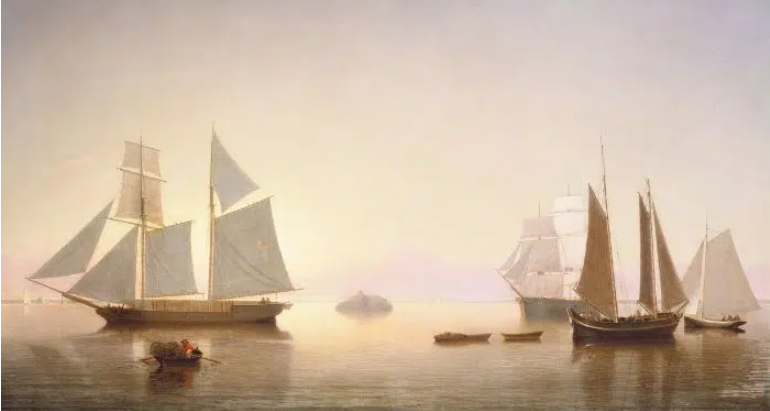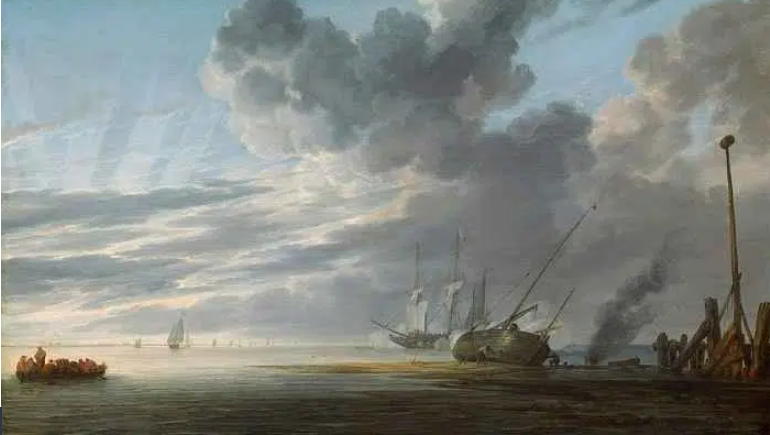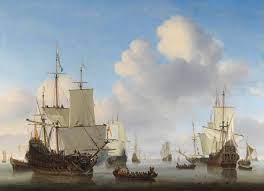Top 10 Renowned Ship Paintings of All Time
- 1. The Fighting Temeraire (1838)
- The Fighting Temeraire (1838)
- 2. Storm at the Sea of Galilee
- 3. A First-Rate Warrior Driven on the Reef of Rocks
- 4. Becalmed Off Halfway Rock
- 5. Breezing Up
- 6. The Home Fleet Saluting the State Barge
- 7. Seascape in the Morning
- 8. Dutch Men-O'War and Other Ships in Calm
- 9. The Slave Ship
- 10. Fisherman's Boats at Saints-Maries Beach
Ship art is a significant category in the broader realm of art, capturing various themes and feelings. These artworks portray naval battles, trading vessels on the sea, ancient exploration ships, mighty leaders, pirates, and more.
Most renowned ship artworks stem from the Age of Exploration and the Age of Conquest, spanning the 16th to the 18th centuries. The swift progress in sea technology sparked a transformation in the maritime sector. To cater to the needs of dominant sea powers like Portugal, Spain, and the British Empire in the late 19th century, numerous ships were built.
The vessels from the trade-centric period played a crucial role in boosting economies and facilitating commerce between Europe, America, and Southeast Asia. Ship artworks likely attract both art enthusiasts and history buffs.
Now, let’s have a closer look at the top ten ship artworks globally. Ready? Let’s go.
1. The Fighting Temeraire (1838)

The Fighting Temeraire (1838)
This artwork is among the notable pieces by Joseph Mallord William Turner. It showcases the final voyage of the 90-gun HMS Temeraire, being moved from the Thames River in London to Rotherhithe to be dismantled.
Created in 1838 with oil on canvas, this painting drew many due to its bright hues and symbolic elements. Made during the Romantic period, it also highlights the rise of steam-powered ships.
The veteran vessel, once feared by enemy states, played a crucial role in the 1805 Battle of Trafalgar between the British Royal Navy and the combined fleets of Spanish and French Navies.
The ship is shown in the painting with a white flag instead of a Union flag. This was done because the warship was over 40 years old. In 1839, the Royal Academy displayed it with a quote from Thomas Campbell’s poem that Turner adapted. It read: 'Ye Mariners of England, The Flag that braves the battle and breeze, No Longer Owns Her'.
Turner's depiction of the tugging scene is controversial. Some people believe that he saw it or imagined it. He has nevertheless portrayed this glorious old warship that was once the pride and joy of the British Naval Fleet.
The new PS20 note will be issued in 2020. However, the original is on display at the National Gallery of London.
2. Storm at the Sea of Galilee

Storm At The Sea Of Galilee, Rembrandt Van Rijn
One of the most famous art thefts is the 1633 oil painting by Dutch Baroque painter Rembrandt van Rijn. The calm work shows the biblical story of Jesus quieting the storm in this sea as described in the holy bible. This is the only seascape by the artist. It was, however, stolen from the Isabella Stewart Gardner Museum in Boston in 1990.
The painting is still missing, and the mystery surrounding its theft has not been solved. It has made the news a number of times.
The picture shows Jesus sitting calmly while his disciples try to stay composed as a storm has hit their boat. They are anxious, but they hide it and rely solely on Jesus for help.
The painting may not be very dramatic or exciting, but it has a spiritual effect on many. Rembrandt beautifully captured the emotions and feelings felt by his disciples.
3. A First-Rate Warrior Driven on the Reef of Rocks

A First-rate Warrior Driven On The Reef Of Rocks, George Philip Reinagle
In the eighteenth century, ship paintings were commissioned by merchants and other wealthy patrons. Artists sometimes included famous ships as part of their works. George Philip Reinagle is recognized for his marine artworks.
He highlighted the ever-shifting seas and the strength of the waves, which wrecked many renowned vessels.
John Henry's 1836 artwork stays true to its name, showing a vessel amidst turbulent waters. This piece underscores one of the gravest dangers of sea voyages: the potential loss of life for sailors trapped in fierce storms.
The painting stands out because it depicts a scene so lifelike it feels almost immediate. It also evokes thoughts of the countless lives that might have perished in such rough waters.
4. Becalmed Off Halfway Rock

Fitz Hugh's 1860, Becalmed Off Halfway Rock
A lot of ship-themed art showcases ships in battles or against massive waves. Few ship paintings portray the tranquility of the seas.
Fitz Hugh's 1860 painting is one such example. It beautifully depicts a scene that people from outside the maritime world will never be able to experience. The painting depicts a ship near Halfway Rock, an important marker between Boston and Cape Ann.
This was a popular halting place for merchant ships and supply vessels. At this point, they could catch up to other boats, promote their businesses, and relax on land.
The painting depicts two large anchored ships and three moving boats. If you look closely, you’ll notice that the ships transport cargo. This painting is now located at The National Gallery in Washington.
5. Breezing Up

A Fair Wind/breezing Up Between, Winslow Home
Winslow Homer created the painting A Fair Wind/Breezing Up between 1873 and 1876. It depicts a catboat, three young lads, and a man. This artwork is very popular and well-recognized in America. The painting is rich in different symbolic elements. The rough sea contrasts with the tranquility of the men in the boat.
The piece shows a sense of hope. In fact, it genuinely embodies the American spirit of that era. The anchor at the boat's front symbolizes aspirations for a bright future. This bright future is about to come true in the United States, a new country at that time.
The artwork displays the growing impact of Japanese art on European artists. This kind of impact was really noticeable in the 19th century. Homer traveled to France. There, he got inspiration from painters like Gustave Courbet and Claude Monet. He finished this painting in 1876. The picture mirrors the artistic influences of that period.
6. The Home Fleet Saluting the State Barge

Jan Van De Capelle - Marine Parade
Jan Van de Cappelle stands as one of the globally acclaimed artists. His masterpieces vividly convey the essence of maritime journeys and the associated feelings. Instead of depicting turbulent waters and clear skies, he chose to paint ships and looming clouds.
Seafaring or marine travel gained popularity in the 16th and early 17th centuries. Many people made fortunes from it. The seafaring culture also influenced the formation of new nation-states and communities. Sea voyages of discovery also made it possible for many cultural exchanges between diverse ethnic and religious groups.
Cappelle, a Dutch painter, was well-known for his seascapes and river views that included many ships. In this work, two yachts fire salutes at the sailors or officials sailing in a state-owned barge. The water is almost crystal clear and calm, reflecting the image of the passengers and vessel.
The 1650 artwork shows ships in a harbor. Saluting a departing vessel highlights the prominence of maritime journeys, especially for the Dutch Empire.
7. Seascape in the Morning

Simon De Vlieger, 'morning Seascape'
Simon de Vlieger created the piece between 1640 and 1545. Born in Rotterdam around 1601, Vlieger tells a tale of resurgence after challenges in his 'Morning Seascape'. He employs the hues of the sky to convey this.
In one part of the painting, the sky appears overcast, with a sailor on a distressed ship in view. On the opposite side, the sky is darker, and an individual on a damaged vessel can be seen. It remains uncertain if the figure is showing thankfulness or hoping for salvation.
The main ship in the middle appears to be heading towards the horizon. Nearby ships seem like dim silhouettes, more so as they approach the horizon.
Beams of white light from the clouds suggest a hopeful horizon. As dawn breaks, the ships appear to have weathered a stormy night at sea. Many perceive the artwork with a sense of hope, almost in a spiritual sense, reflecting life's challenges.
8. Dutch Men-O'War and Other Ships in Calm

Willem Van De Velde Ii - 'dutch Naval Vessels And Other Boats In Calm Waters'
Willem van de Velde II was a Dutch artist from the 17th century. He was well-known for his marine paintings. He made a significant name in this genre of art. At that time, ships represented advanced tech. More importantly, navies were very important for national security.
In 1665, Willem van de Velde II painted 'Dutch Naval Vessels and Other Boats in Calm Waters'. This picture highlights the Dutch Navy's grand fleet. It focuses greatly on the powerful Men-O'-War ships. These massive vessels were armed with strong weapons. Thus, they could quickly dominate other ships and shore defenses. They even could destroy the whole towns.
You can see many of these ships in the painting. "Men-O-War" was a common phrase at that time. It indicated a ship equipped with cannons or sails.
9. The Slave Ship

"The Slave Ship" By J. M. W. Turner
This standout piece by J.M.W Turner is both engaging and somber. It highlights the tough realities of its time. At a quick look, it portrays a ship amidst a turbulent storm. The ship's delicate masts hint at potential danger. The sky's deep and reddish hues bring a feeling of concern to those observing.
The painting showcases a sorrowful ship and a distressing situation. It features an individual tied up with feet shackled. The subjects are obviously slaves on a ship facing peril. While Turner's approach is a bit blurred, he uses bright hues and clear brushwork to convey the emotions in the scene.
Such tragic incidents weren't rare back then. Slave ships were sometimes intentionally sunk to curb disease outbreaks. While these actions were heartless, they mirrored the societal standards of the time.
Turner drew inspiration from events like the Zhong Massacre, where a slave ship's crew cast overboard 54 female slaves, several kids, and numerous dissenters.
10. Fisherman's Boats at Saints-Maries Beach

Fisherman's Boats At Saints-maries Beach By Van Gogh In 1888
The enchanting 'Fishing Boats on the Beach at Saints-Maries' is one of the many paintings made by Van Gogh in 1888, when he traveled to Saintes-Maries-de-la-Mer on the Mediterranean Sea. Back then, Saintes-Maries was a tiny fishing hamlet with fewer than 100 people living there.
The boats were sketched using a reed pen, and the methods and lines he employed reflect the impact of Japanese artworks on him. The painting captures the daily life of people in the area, while the seaside scene reflects harmony and balance. The seascapes he painted were a ray of hope for him to continue doing what he loved, even though he was sick.
He applied the colors using a palette. To create waves, the white and blue sea regions are overlaid with green and turquoise. This technique gives the image a more realistic appearance and is charming.
No Comments Yet...